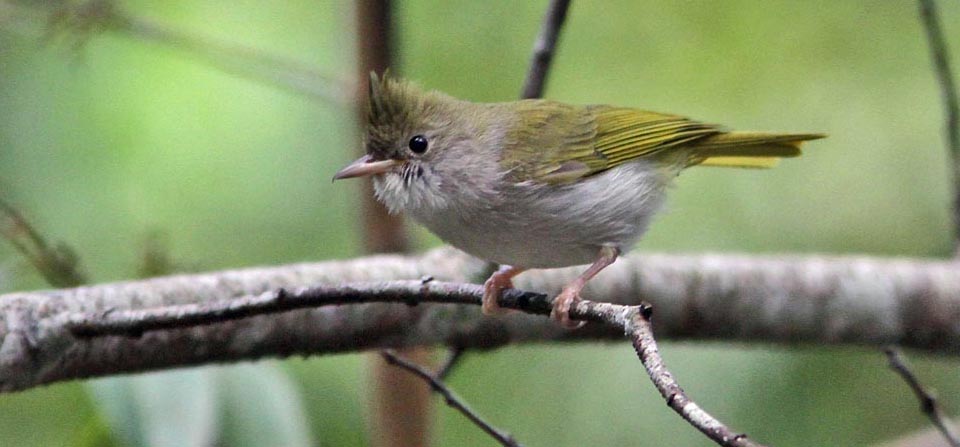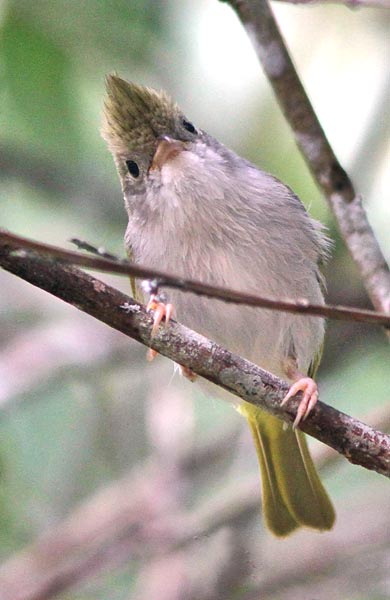
a web page by Don Roberson |
ERPORNIS Erpornithidae |
|
Also wrong was the belief that vireos had no relatives in the Old World. In molecular studies of the traditional Timaliidae [Babblers], it was discovered that a vireo-relative was hidden in the "babblers" (Cibois 2003, Alström et al. 2006, Reddy 2008). This bird was then known as White-bellied Yuhina Yuhina zantholeuca. This was a truly shocking discovery! No one had guessed that from its appearance or behavior — if anything, it recalled a titmouse. This bird is now called White-bellied Erpornis Erpornis zantholeuca, or sometimes just plain Erpornis (left and all other photos below). The old traditional "babbler" family is now split up into multiple families; e.g., Alström et al. (2006), Gelang et al. (2009), Cibois (2010) [see the page on the Timaliidae for details]. Further research also revealed that another set of "babblers" — the shrike-babblers of south Asia — were also related to New World vireos (Reddy & Cracraft 2007, Reddy 2008). At this moment, most world checklists place both Erpornis and the shrike-babblers among the Vireonidae. Because shrike-babblers diverged from the vireo lineage about 30 million years ago, and Erpornis diverged about 24 mya, I prefer to place them in separate families. More details on this decision appear on my Shrike-babbler page. [In another oddity, most of the rest of the Yuhinas (genus Yuhina) are now been placed in the White-eye family [Zosteropidae]. |
 |
The White-bellied Erpornis (above & right) is a reasonably common and widespread Asian passerine, found primarily in foothill broadleaf evergreen forests from Nepal and northeast India to south China (and Formosa) and through southeast Asia to Borneo and Sumatra. It is often in mixed species flocks at mid-canopy — singly or in pairs or family groups — and does remind me of American titmouses with its raised crest and perky behavior. It is decidedly bigger-billed that any of the tits, however, and I can something that is "vireo-like" in the broad, hooked bill. Although it eats a wide variety of insects, it may specialize in part on small grasshoppers or bush-crickets, and small caterpillars. It is also known to eat berries, figs, seeds, and flower nectar (Collar & Robson 2007). Typical calls are described as "loud peevish nasal 'nher-nher' or 'jeeer-jeeer-jeeer,' interspersed with dry trills. I recall that in Thailand (where these photos were taken) it was often found in wintering flocks of migrant Old World warblers, thrushes, and resident cuckoo-shrikes, by its vocalizations. |
| Photos: The White-bellied Erpornis Erpornis zantholeuca was at Khao Yai NP, Thailand, on 25 Dec 2012. All photos © Don Roberson; all rights reserved. |
Bibliographic notes There is no "family book" on Erpornis (indeed, I am about the only one assigning them Family rank at the moment) but the Handbook of the Birds of the World account (Collar & Robson 2007) is excellent, with great photos, although it is not quite up with the most current taxonomic findings. Literature cited:
|
 In
what now seems like a long time ago, the ground-breaking DNA-DNA
hybridization studies of Sibley & Ahlquist (1990) discovered that a
huge Corvoid assemblage had arisen in Australasia, and part of that
assemblage were vireos, then thought to be a completely New World
family. Indeed, traditional taxonomy listed it just before the New
World warblers. This was completely wrong.
In
what now seems like a long time ago, the ground-breaking DNA-DNA
hybridization studies of Sibley & Ahlquist (1990) discovered that a
huge Corvoid assemblage had arisen in Australasia, and part of that
assemblage were vireos, then thought to be a completely New World
family. Indeed, traditional taxonomy listed it just before the New
World warblers. This was completely wrong.